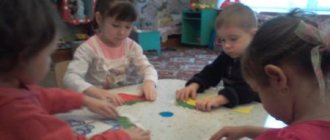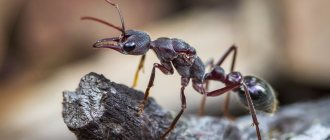Summary of a lesson in the educational field on the topic: “Insects”
Author: teacher Kalnitskaya Tatyana Aleksandrovna.
MBDOU Kindergarten No. 1 “Firefly” Skopin.
Lesson notes for the junior group on the topic: “Insects”
Summary of a lesson in the educational field “Cognitive Development” in the junior group.
File: Lesson notes
Target. Clarifying children's ideas about insects and their characteristic features, about the dependence of their color on their habitat (mimicry).
Tasks.
— Consolidate knowledge of sensory standards (the ability to compare and group objects by color). — Develop visual perception and imagination. — Foster a caring attitude towards representatives of the animal world.
Activation of vocabulary: insects, flutter, silhouette, brown, black, chirp, color.
Equipment: toy insects (ladybug, grasshopper, ant, butterfly, beetle, dragonfly), models of autumn and summer meadows, sheets of colored paper, glue, brushes, napkins, silhouettes of insects, ICT.
Progress of the lesson.
Educator. The children, the ladybug and her insect friends invited us to visit, I suggest we go to their autumn meadow. (Music sounds)
We came out to a forest clearing, raising our legs higher, through bushes and hummocks, through branches and stumps. Who walked so deftly without tripping or falling?
Educator. So we came to the autumn meadow. Children, what do you see on her?
Children. Twigs, stump, anthill, leaves.
Educator. And where are the small inhabitants of the clearing - insects? Why aren't there any? What season? That's right - it's autumn. And in the fall there is little sun, it’s cold, the flowers have wilted, and there is nothing for insects to eat. And so they hid under the bark, under the leaves.
Educator. Children, let's remember the time of year when it is warm, the sun is shining brightly, flowers are blooming, and the grass is green. Right! This summer! (A song about summer sounds.)
Educator. Children, do you want to go back to summer? Let's show how the warm summer breeze blows. (Children run on their toes and make smooth movements with their arms.)
Educator. So we found ourselves in a summer meadow. Children, what do you see on her?
Children. Grass, flowers, anthill, stump, ladybug.
Educator. Ladybug, why are you alone?
Ladybug. My friends and I are playing hide and seek. Everyone is hiding, but I can’t find them.
Educator. Children, do you know who Ladybug's friends are?
Children. Insects.
Educator. What insects do you know?
Children. Ant, butterfly, beetle, dragonfly, grasshopper.
Educator. Ladybug offers to guess riddles about her friends and try to find them in the clearing.
Jumping champion Jumps and gallops across the meadows. (Grasshopper) That's right, grasshopper. Here is his portrait, what color is it?
Children. Green.
Educator. Children, let's look for a grasshopper in the clearing. (Children find a grasshopper and place it on a tree stump next to the ladybug.)
Where was the grasshopper hiding? What color is the grass? Yes, the green grasshopper was hiding in the green grass. Guess the riddle:
He drags the straw to the small house. He is stronger than all the insects. Our hard worker (ant)
Educator. Yes, it's an ant. Look at the picture, what color is it?
Children. Black.
Educator. Where did he hide? (Children find an ant and place it on the stump of a ladybug.)
Educator. Children, where did you find the ant? Why was he hiding on the ground? That's right, the earth is black and the ant is the same color.
Listen to the following clue: Here is a blue helicopter flying over the water: Tail, wings and eyes
It's simple (dragonfly).
Educator. That's right, it's a dragonfly. Here is her portrait, what color is she? Where will we look?
(Children find a dragonfly and place it on the stump of a ladybug.)
Educator. Where was the dragonfly found? What color is the water in the stream? Blue dragonfly and blue stream. Next riddle:
Zhu-zhu, zhu-zhu. I sit on a branch, I always repeat the letter Z (beetle).
Educator. Well done - this is a bug. Here is his portrait, what color is it? Where will we look for him? (Children find a beetle and place it on the stump of a ladybug.) Educator. Children, where was the beetle hiding? What color is the bark on the stump? What color is the beetle? Yes, they are brown. Listen to the riddle:
All four petals of the flower were moving. I wanted to pick it, He fluttered and flew away (butterfly).
Educator. Yes, it's a butterfly. Look at the picture, what color is it? Butterflies come in different colors: red, white, blue, ours is yellow. Lemongrass. Let's find her. (Children find a butterfly and place it on the stump of a ladybug.)
Educator. What color is the butterfly? Where did you find her? What color flower was the butterfly hiding on? That's right, the butterfly is yellow and the flower where it was hiding is yellow.
Gymnastics for the eyes “Butterfly” (The teacher is holding a toy butterfly on a stick in his hands.)
Educator. And here comes another butterfly. Follow the butterfly with your eyes. The butterfly flies everywhere: it flies to the left, it flies to the right. The butterfly flutters in a circle, hurries up, down and back.
Educator. Ladybug, we helped you. That's how many little inhabitants we found! Ladybug. Thank you guys, we played so well: you found all my friends.
Educator. How can the little inhabitants of the clearing be called in one word?
Children. Insects.
Educator. Guys, do insects have enemies?
Children. Eat.
Educator. Who?
Children. Birds, people, animals.
Educator. How do insects escape from enemies? (Pay attention to the color of insects.) Where is the green grasshopper hiding? Where's the brown beetle?
Children. A grasshopper is hiding in the green grass, a beetle is on the branches, under the bark of trees.
Educator. Why do they need this coloring?
Children. Protect yourself from enemies, hide.
Educator: Guys, why shouldn’t we touch or offend ladybugs and other insects?
Children. They are alive.
Educator. Yes, insects are alive. They cannot be offended. But you can admire them. Watch them fly, run, jump, play, listen to them buzz and chirp.
Educator. Now let's turn into a grasshopper:
“Raise your shoulders! Jump grasshoppers! Jump-jump, jump-jump! We sat down, ate some grass, listened to the silence. Again, jump high, Jump deftly and easily!”
Educator. Guys, look at the ladybug. She's so bright! It is clearly visible in the grass and on the bark of a tree. Any bird will notice it. Where should she hide? It turns out that the ladybug doesn’t have to hide, because she has a secret: she herself knows how to defend herself from enemies. In a moment of danger, she secretes milk, which smells very bad, so no one eats the ladybug. And since she, like a real cow, gives milk, then she was called “ladybug”. It is bright red for everyone to see: it is dangerous to eat!
Educator. Little insect inhabitants of the clearing want to give a gift. They have prepared their images for you - silhouettes and colored paper. I’ll tell you what to do with these gifts when we return to the group. It's time for us to return. Let's show again how the warm, summer breeze blows. (A song about summer sounds.)
Educator. You need to hide the silhouette of one of the inhabitants of the clearing: place it on the sheet on which no one will find the insect and glue it. What color is the silhouette of your insect, what color sheet did you hide it on? You hid your insects well - they sit on sheets of the same color as themselves. This means that no one is afraid of them. In the evening we will make a book out of these sheets, show them to moms and dads, come up with a name together, and then place it in our corner of nature.
Educator. Where have we been? Who did you see? Did you like it?
Our lesson is over.



